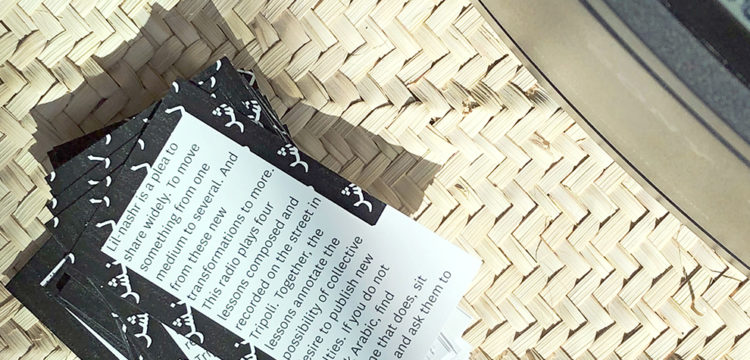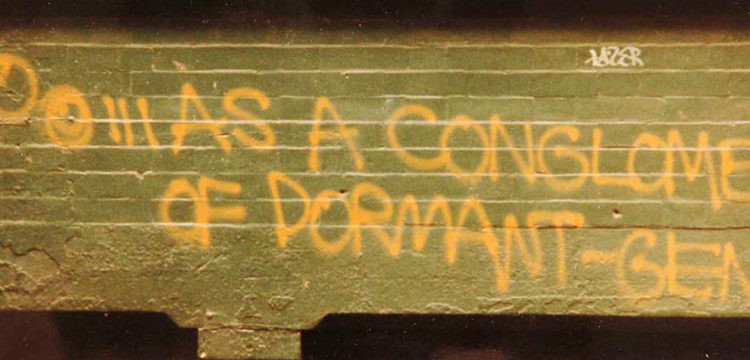Forms, Uses and Commensality
How they make things do things
This text was first published in Spanish on Materiales Concretos, in September 2019, and translated into English by George Hutton.
Uses, commensality and frequency
In order to speak of use, we need to rid the word of all pragmatist interpretation. That is, rid it of its many guises, and of its association with any given purpose. In other words, we would need to consider the verb “to use” in isolation, and observe it in the rawest possible state: in the middle of an action, in a particular case. We would need to separate a thing’s use from its intention, or at least be allowed to ponder over what its use might be; let it consist of urges, and little else. Only then are we left with the word “use” in the sense of what you do with something. This is not about considering the act of “using” as if it were autonomous or isolated, using for using’s sake, but rather the idea is taking this word so that purpose itself is not in fact the main concern, and any subsequent effects are allowed to be a surprise. Within this logic, “using” is not unlike enjoyment, insomuch that the real value of enjoyment lies in how it lacks morality and sparks imagination. There is no such thing as “good” or “bad” enjoyment. One enjoys something, and only later can this be judged or somehow condemned. That is, the experience of enjoyment is infinite, and it leads us down paths that would otherwise be unthinkable within more rational or moralistic processes. It rocks up and gets off. Enjoyment derails knowledge, and it therefore consists of material that is apt for both the production and the reception of the work of art. Starting with this logic, in order to answer the question “what is useful?”, it is worth stating that useful is what is used, what can be used.

Bulldozer at work in a marble quarry in Thasos, Greece
In La siesta de las cosas (2000), Ángel González notes that, probably, the fundamental use of art is its commensality. That is, its ability to convene a group of people around a given thing. In Castilian Spanish, the term “comensal” describes the person with whom we are sharing a meal, whereas in Portuguese the same word refers to that person if indeed they eat together frequently. The Portuguese language retains something of the Latin root here, i.e. commensalis, or “table companion”, one’s fellow diners. That is, commensality implies a certain degree of regularity. In this sense, to speak of commensality would suggest that “using” art needs, by definition, to be a common occurrence. Meanwhile, the useful, or what is used, often becomes “the usual”; and so, in some way, uses and commensality tend to be merged into the same scene. It is worth noting here the legal difference, as applied in Spain, between “uses” and “customs”. While customs generate legality and are a source of law, as long as the community in question accepts that things must necessarily be done a certain way, uses are of a lower esteem: they complete or interpret previous rules. Despite the fact that what is used can potentially create a new custom, more often than not the usual gradually transforms according to how it is used, and so uses consist of behaviors that are sporadic, ever-changing, and not aiming to become a rule. Therefore, to state that a use—something usual, or one’s company at the table—needs to be a frequent occurrence, does not imply that it must be repetitive (having become used to it). The frequent can be, at the same time, changing, sporadic and indescribable, because uses are modified each time.

Folding table in cabin.
On the other hand, the word commensality itself alludes to the existence of a mesa, a table: the structure itself, that which is used and which allows that meeting or get-together to happen. Luckily, quite a few of us fit around that table. Following the analogy drawn between the work of art and the table, it is important to discuss form here. In terms of the form of this table (or of this work of art), the relevant point is not exactly what we see, but rather the form in which such a table makes us do things, or indeed makes things do things. Not so much visible things, but rather what is passed on in the process, what it infects us with. And, logically, this form that makes things do things will never be clearly defined or precise because, given that it deals with a use, not a custom, it is different each time, even with the same person. Therefore, many forms are made (used) starting with one and the same table, and, consequently, the result is a form that draws in, brings together, and contradicts. It is made up of different layers of reactions, gestures and movements.
(Un)veilings, awakenings
In imagining how this kind of form is concocted, i.e. this form that is passed on or made as a result of commensality, of this coming together, I suppose that the process would look something like Velázquez’s revisions, his so-called “regrets” or pentimenti. In Velázquez’s paintings, the forms that he originally tried out have slowly been unveiled over time, from beneath the glaze, to the point where animals’ legs have turned into a string of ghostly figures or outlines. What we see today—these many legs—were not previously visible, but they have gradually been unveiled, perhaps awoken, until they concocted the form we see today. A form is never entirely there; instead, what we see is made up of a mixture of attempts, negotiations between force and chance.
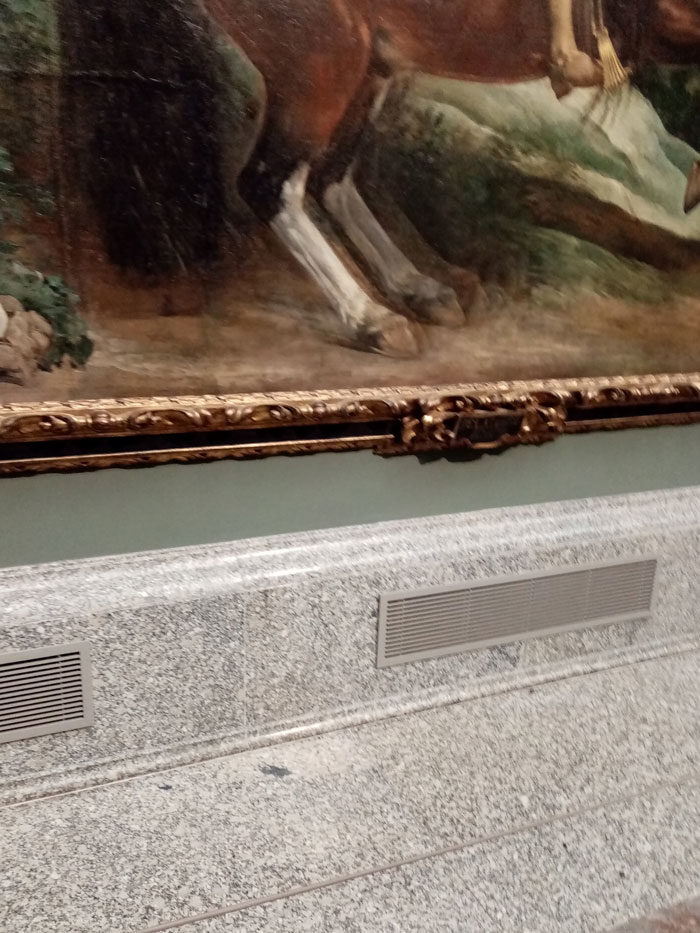
Detail of the painting Philip IV on Horseback (1635) by Diego Velázquez, in which the painter’s pentimenti can be observed.
The word “unveil” is in fact part of the same etymological family as “vigil”, i.e. the act of keeping watch at night. Its root in Proto-Indo-European, i.e. *weg-, is also the source of the English word “wake” and its Spanish cognate vela, “candle”, and it originally meant strength or vigor, necessary to carry out such night-time vigilance. Therefore, being vigilant literally implies being imbued with strength, or indeed with one’s strengths “alive and kicking”. The Spanish word for “glaze”, veladura, is also part of this same family, forming a “veil” over the painting, protecting it, watching over it, attentive, awake: another form of vigilance. In turn, somebody who is woken up is suddenly deprived of sleep because some vibrant force has made them pay attention to what is happening out there in the dark. When there is a lack of light, the rod cells in our eyes take over the task of supplying vision. Our eyes might glaze over. Unlike the cone cells, which are situated in the centre of the eye and which allow us to see all the colors we know, the rod cells are situated on the outer edges of the retina and cannot distinguish color or discern detail, but they are extremely sensitive to any light stimulus. Therefore, objects remain invisible to the fovea when there is little light, and we only perceive them, albeit without color, via the outer parts of our eyes. Furthermore, in these conditions the pupil opens up so much that the light enters from various different directions, blurring the projected image that reaches our brain.
Therefore, those woken up in the night only have the outer cells at their disposal and light is hitting their pupil from too many directions, and so whatever that person puts all their focus and strength into (*weg-) will invariably be blurry. Both the person awoken in the night, and the ghostly brushstroke unveiled over time, have somehow cheated their own death: the image is made up of many layers of contradiction. I try and think of how commensality makes things do things, just like these (un)veilings and awakenings make things do things, or make us do things. And so I imagine that, even if the table is used often, the act of commensality itself is not necessarily simultaneous, with confusing conditions for its action and visibility. Those sitting at the table (the “comensales”) are choosing not to lie down, just like the pentimenti too refuse to lie down, cheating death, emerging from behind the glaze: as such, the actual chronology of the whole piece is drastically reformulated.
The form of applause
And those vigorous forces of the (un)veiling process, shaking about in the shadows, undoubtedly give rise to something. Perhaps another new image, with a different form. I think this produced image has the form of applause, and the collective display of acclaim is a form that brings with it various different ways of applauding. They include: whistles, foot-stomping, standing up, loud clapping, polite clapping, and clicking. It also entails the relevant contradictions, such as tears, booing, and the conscious decision not to clap. Yet applause cancels out all personality, since, amid the racket, it is difficult to identify the actual sound itself. It scatters, it is fleeting, and it has to be constantly reinvented. In this sense, the form of applause is similar to what we tell ourselves is true.
It is said that we applaud because we cannot slap those who have so pleased us on the back, which is what we would really like to do. Offering bodily heat by slapping someone on the back feels like a sporting conduct of some kind; it responds to a primal need to resupply the body with heat after it has been used up. Today, applauding as a group is a way of heating up our hands and some of this heat is probably transferred over to the space, and so the contemporary version of this action retains something of its origin, of wanting to slap someone on the back, resupplying a place with heat after it has been used up. Applause is thus not a “real” form, let’s say, but instead it is the representation of an older gesture, a more animal or practical one as it may be. Also, “applause” is very close to “plausible”, i.e. that which is feasible or possibly true. Therefore, applauding not only represents congratulations and appreciation, but it also makes a statement. Again, applauding is a form that points out what is true, it confirms the belief in this truth, as well as agreement with it (it lasts for a mere moment).
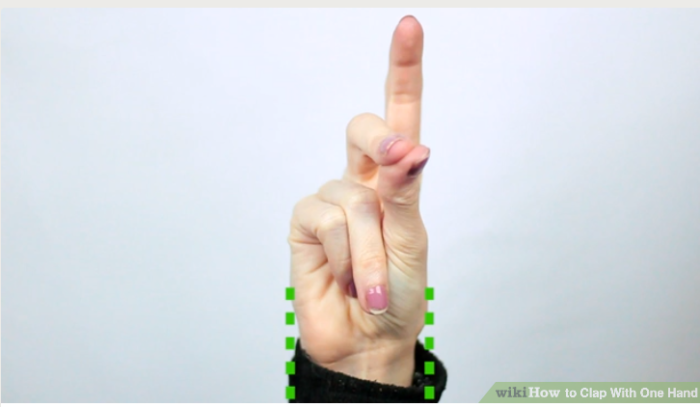
Instructions on how to clap with one hand, wikiHow.
At the same time, there is another line of interpretation that explains applause as a way of marking a distance between ourselves and that which has so moved us, to prevent it from swallowing us up. This analysis implies that, by framing the event with the gesture of clapping, we place ourselves in a more or less unaffected position, removed from the event, because one hardly ever applauds life itself. What often happens is that the final applause is rousing, yet it also shatters the illusion, which crashes back down to earth and bids us farewell. I now wonder if there is perhaps a link between the movement of the hands that applaud, and the hand that waves goodbye; not so much a similarity, more an easing of the transition from one gesture to the other. Applauding, then, is not only a form of affirmation, belief and appreciation, but it is also a wall: I thank you, I agree with you, and I deem it to be true, but this happens externally to me. Essentially, the form they have made us do is not only useful for capturing and thanking a momentary truth, but it also serves, despite everything, to place us in relative indifference to that which has just been true.
And the scene takes the form of applause. How the work affects the real
To recap, the work of art or the table—as infrastructure—upon being used, concoct a kind of commensality, a coming together, that operates by means of unveilings/awakenings, an emergence, an appearance, leading to something that takes the form of applause. The form makes the thing (us) do a thing. It is important to note here that, although commensality generates that which has the form of applause, and that this is a side effect and not the final objective, this matter is still worth considering in a little more depth. We should focus on what appears when the infrastructure, when used, makes things do things, because said effect, in the form of applause, will be what ultimately makes apparent the transformations of the work of art upon the real. This effect is nothing other than the scene: not in the theatrical sense, but rather what happens between those who share a certain time or place. It consists of non-continuous and unpredictable relationships that evolve as they go along, and they go off in directions that we could not even imagine. Any urban planner or designer must acknowledge that all spaces are re/inhabited and they come to modify their intended function. Even eminently practical projects, like a ramp or a car park, lead to scenes that nobody could have ever suspected, and yet these happen due to the very form of the place (the infrastructure) that they occupy. We can think of the places that commensality takes us to, not as places that are familiar to us but rather places we are not quite so familiar with. Commensality tests our abilities to relate with the new.
More than 2500 years ago, skené (the Greek word from which “scene” is derived) referred to the modest cabin in which priests would change their attire during different Dionysian rituals, and before long this hut had turned into the elaborate construction upon which the priests would make their appearance—the scene, the setting, the stage. Considering the word “scene” today, as a thing which is made to do things (or pass on things) by the very infrastructure of commensality , I think it is fitting to link it with its origin as a small changing room. The scene provided to us by commensality is ultimately a specific place which serves to cover up a transformation.
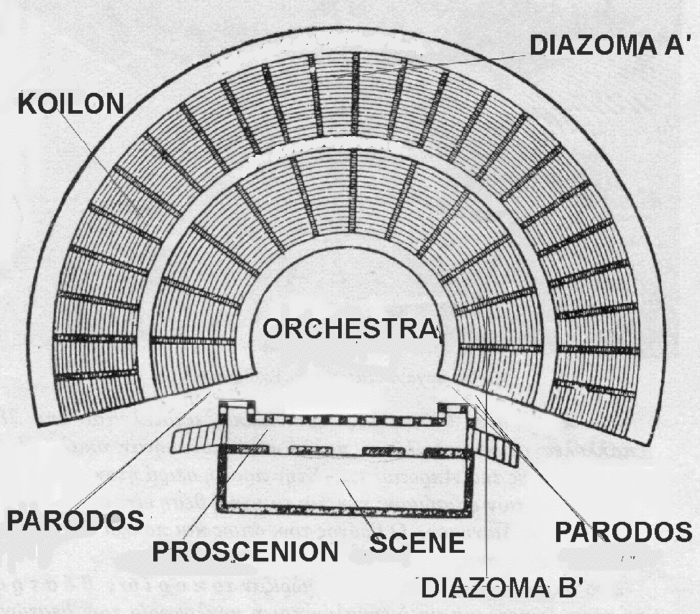
Plan of a Greek theatre.
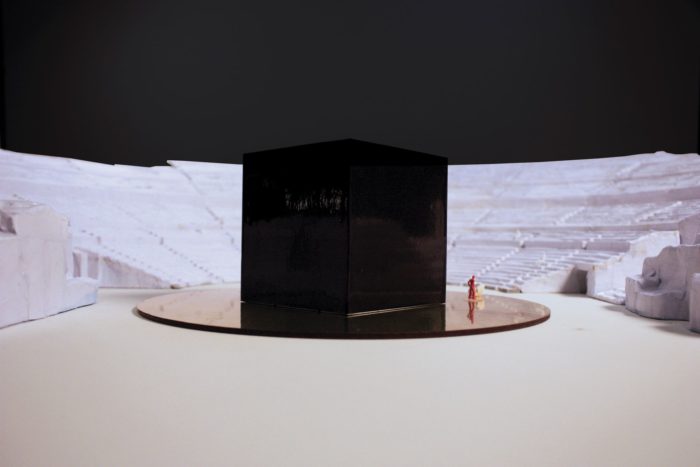
Scale model of a Greek theatre.
We cannot know for sure why exactly it was necessary for priests in Ancient Greece to be covered up as they disrobed, but we can speculate as to the reasons. I doubt they would have covered up solely out of modesty or shame, quite the contrary—these huts or scenes (skené) probably had the effect of triggering desire. The original function of the scene, that small hut, would be almost identical to that of any sheer fabric or wrapping paper, given that “not seeing”—which is sometimes deemed a “mystery”, other times “not knowing”—is the key element in the concocting of passions and appetites. It is therefore unsurprising that proclaiming mystery and covering up have been two fundamental devices in religion. The word is understood here not in the institutional sense, but rather as connected to its Latin root ligare “link, bind”, in the sense that religion is what connects us with life itself. Perhaps those who decided to cover up the wardrobe changes in the passages of the Dionysian rituals had already realized that we fall in love through interruptions. That is, they knew that for human beings to be bound to a life—which is ultimately concocting love, falling in love—it is essential that not every single part is revealed. They have to consider what they cannot see, and, therefore, what they so desire.
The phenomenon is material
Each scene either covers up or constructs in order to obstruct vision. We have concocted a commensality that accustoms us to not distinguishing between the two, and it thus turns the surreptitious into something habitual. If we want to talk about what is happening in a place we cannot really see, we can use the word “hallucination”. Then, etymologically speaking, being in the scene is about “wandering around among false lights”. I say “false” not as something less valid, but because none of the lights that are created in the scene can be considered the truth. The scene happens and, essentially, at the very most one wanders among the lights that have appeared, that have made an appearance. The scene’s fictional and flickering light is just the phenomenon, literally “what is shown”. Therefore, the phenomenon is anything that manages—by means of devices such as the phantom, fantasy, the diaphanous or emphasis—to go from being a figment of the imagination to being an object. It manages, momentarily, to materialize. In Spanish, a phenomenon that blows your mind may indeed make you hallucinate, but not in the spiritual sense, let’s say, but rather in the very material sense, right here. Such an image might be, for example, when you take a liquid and boil it down until you see that béchamel where there was also an alien landscape that you are walking in and then all the screens crack. Sparks, white flames, ashamed, filled up with another old lady, you stop the traffic light, enunciating, and this. You can put any word next to any other word and they all make each other do things.
Phenomenon itself is matter and material, since “what is shown” (that setting that we can barely make out) affects thought, sensibility, it transforms what we say and, therefore, what we do. And vice versa. That is, the following scheme: setting/scene <—> emotion/thought <—> action <—> thought/emotion <—> word/speech works in both directions, and its flow determines, essentially, whether we can use art or not. In our case, the invention of the Greek alphabet was not what led us to think in an abstract, continuous and lineal way, but rather the ability to imagine an alphabet in a line probably came about in that civilization because of its coastal location. Greece, with its 14,000km of coastline (the longest relative to the size of the country), is the setting in which the immense horizon that separates the sky from the sea has been most present. It has thus been suggested that the (omni)presence of such a line was what led the inhabitants to think in such a lineal way. If we manage to understand something, it’s because of what lies behind it.




